
Bolton Abbey Estate in Wharfedale, North Yorkshire, England, takes its name from a 12th-century Augustinian monastery of canons regular, now known as Bolton Priory. The priory, which was closed in the 1539 Dissolution of the Monasteries ordered by King Henry VIII, is in the Yorkshire Dales, which lies next to the village of Bolton Abbey.

Anfield Cemetery, or the City of Liverpool Cemetery, is located in Anfield, a district of Liverpool, Merseyside, England. It lies to the northeast of Stanley Park, and is bounded by Walton Lane to the west, Priory Road to the south, a railway line to the north, and the gardens of houses on Ince Avenue to the east. The cemetery grounds are included in the National Register of Historic Parks and Gardens at Grade II*.

Bolton Priory, whose full title is The Priory Church of St Mary and St Cuthbert, Bolton Abbey, is a Grade I listed parish church of the Church of England in the village of Bolton Abbey, within the Yorkshire Dales National Park in North Yorkshire, England. There has been continuous worship on the site since 1154, when a group of Augustinian canons moved from their original community in nearby village of Embsay and started construction of the present building, which is now situated within a scheduled monument under the Ancient Monuments and Archaeological Areas Act 1979. Despite the loss of most of the Priory buildings during the Dissolution of the Monasteries, the western half of the original nave was preserved so that the local parish could continue its worship there. There is today a full liturgical calendar, although a programme of other events, which formerly included the spring Blessing of the Lambs, the Bolton Priory Celebrity Organ Recitals, the Bolton Priory Mystery Play and the Bolton Priory Live Nativity, now only comprises the Bolton Priory Concert Series and the annual St Cuthbert lecture. The Priory is a member of the Greater Churches Network, and pre-Covid welcomed more than 160,000 visitors a year.

Touchstones Rochdale is an art gallery, museum, local studies centre, visitor information centre and café forming part of the Central Library, Museum and Art Gallery in Rochdale, Greater Manchester, England. It is a Grade II listed building.

Hornby Castle is a country house, developed from a medieval castle, standing to the east of the village of Hornby in the Lune Valley, Lancashire, England. It occupies a position overlooking the village in a curve of the River Wenning. The house is recorded in the National Heritage List for England as a designated Grade I listed building.

The Great Gatehouse, also known as the Abbey Gatehouse, is a historic building on the south side of College Green in Bristol, England. Its earliest parts date back to around 1170. It was the gatehouse for St Augustine's Abbey, which was the precursor of Bristol Cathedral. The gatehouse stands to the cathedral's west, and to its own west it is abutted by the Bristol Central Library building. The library's architectural design incorporated many of the gatehouse's features.

Abbeystead House is a large country house to the east of the village of Abbeystead, Lancashire, England, some 12 km south-east of Lancaster. It is recorded in the National Heritage List for England as a designated Grade II listed building.
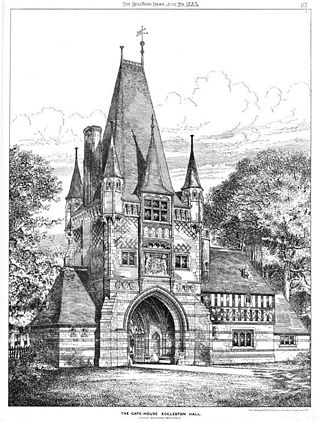
Eccleston Hill Lodge is a gateway and lodge near the village of Eccleston, Cheshire, England. It stands at the entrance of the Chester Approach to the estate of Eaton Hall. The structure is recorded in the National Heritage List for England as a designated Grade II* listed building.
St Oswald's Vicarage is on Parkgate Road, Chester, Cheshire, England. It is recorded in the National Heritage List for England as a designated Grade II listed building.

Saighton Grange originated as a monastic grange. It was later converted into a country house and, as of 2013, the building is used as a school. It is located in Saighton, Cheshire, England. The only surviving part of the monastic grange is the gatehouse, which is recorded in the National Heritage List for England as a designated Grade I listed building, and is one of only two surviving monastic manorial buildings in Cheshire, the other being Ince Manor. The rest of the building is listed at Grade II, as is its chapel.
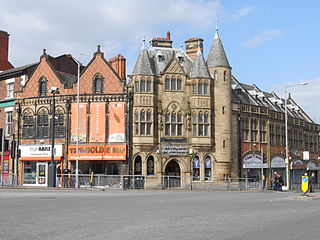
Bank Buildings is a historical construction on a corner site at 1–7 Charing Cross, Birkenhead, Wirral, Merseyside, England. It consists of offices and shops which extend towards the north along Exmouth Street and towards the west along Grange Road West. It is recorded in the National Heritage List for England as a designated Grade II listed building.

Cromer Hall is a country house located one mile south of Cromer on Holt Road, in the English county of Norfolk. The present house was built in 1829 by architect William Donthorne. The hall is a Grade II* listed building.
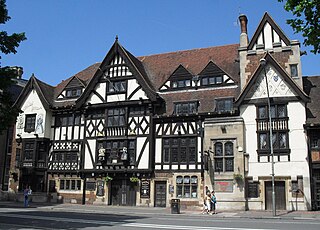
The King and Queen is a pub in the seaside resort of Brighton, part of the city of Brighton and Hove. The present building, a "striking" architectural "pantomime" by the prolific local firm Clayton & Black, dates from the 1930s, but a pub of this name has stood on the site since 1860—making it one of the first developments beyond the boundaries of the ancient village. This 18th-century pub was, in turn, converted from a former farmhouse. Built using materials characteristic of 16th-century Vernacular architecture, the pub is in the Mock Tudor style and has a wide range of extravagant decorative features inside and outside—contrasting with the simple design of the neighbouring offices at 20–22 Marlborough Place, designed a year later. English Heritage has listed the pub at Grade II for its architectural and historical importance.

St Mary the Virgin's Church is a former priory church in the village of Bromfield, Shropshire, England. It is an active Anglican parish church in the deanery of Ludlow, the archdeaconry of Ludlow, and the diocese of Hereford. Its benefice is united with those of 5 other parishes to form the Bromfield Benefice. The church is recorded in the National Heritage List for England as a designated Grade I listed building.

Thurstaston Hall is a country house in the village of Thurstaston, Wirral, Merseyside, England. The house is built in stone and brick, it is in two storeys, and it has a U-shaped plan. The oldest part, the west wing, was built in the 14th century, the central block dates from 1680, and the east wing was added in 1836. The hall is recorded in the National Heritage List for England as a designated Grade II* listed building, and the gate piers in the drive leading to the hall are designated Grade II.

Simonswood Hall is a country house in the civil parish of Simonswood in the West Lancashire district of Lancashire, England. It was built in 1687 and thoroughly restored in the 1880s. The house is constructed in sandstone with a stone-slate roof. There are two storeys with an attic, and three bays, the third bay being a cross wing projecting under a gable. On the left return is a single-storey lean-to extension. The doorway in the central bay has a rusticated surround, with voussoirs and a keystone. There is one window that is transomed, all the others being mullioned; all the windows have hood moulds. The house also has quoins and finials on the gables, which are coped. The house is recorded in the National Heritage List for England as a designated Grade II* listed building.
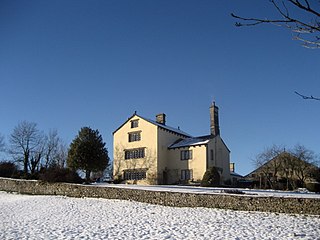
Bank Newton Hall is a historic building in Bank Newton, a village in North Yorkshire, in England.
Longridge Farmhouse is a historic building in Bishopdale, North Yorkshire, a valley in England.
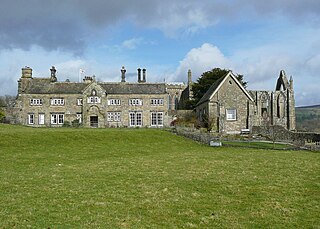
The Old Rectory is a historic building in Bolton Abbey, a village in North Yorkshire, in England.
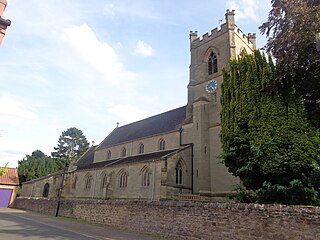
St James' Church is the parish church of Boroughbridge, a town in North Yorkshire, in England.


















